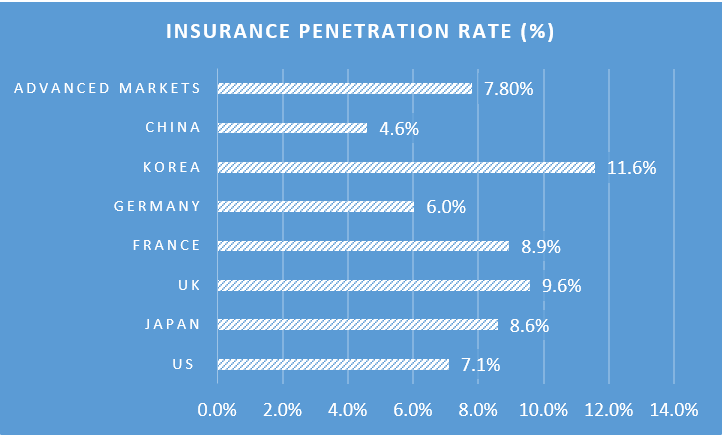
Investing in China: A Post-Covid-19 Perspective [Part 2]
This is a continuation and part 2 to the series “Investing in China: A Post-Covid-19 Perspective”. Click here to read part 1 of the story.

Chinese Leadership in 5G Technology
The ongoing US-China trade war has been casting a spotlight on China’s aspiration to become a leader in emerging technologies. In our view, the economic decoupling between the two superpowers will further encourage China to reduce its dependency on US technology and further solidify its domestic tech companies.
The shift in investments to facilitate innovation is gaining significant momentum in China. According to World Intellectual Property Organisation (“WIPO”), of the 3.3 million patent applications received in intellectual property (“IP”) offices worldwide in 2018, China had chalked up 46.4% of total applications, outpacing the US, Japan, Korea and European Patent Office (“EPO”) combined. Source: WIPO Statistic Database; as of 2018
Source: WIPO Statistic Database; as of 2018
In 2019, for the first time, applicants from China filed the most applications under the Patent Cooperation Treaty (“PCT”) – a unified procedure for patent applications. Of the 265,800 patents filed under the PCT, China had 58,990 applications, representing a growth of 10.6% compared to 2018. The US trailed closely behind at 57,840. In terms of specialisation, China filed intensively for patents related to Digital Communication, while the US filed most in computer technology. [1]
The data signifies why the US is specifically targeting China’s 5G development: On the individual firm level, Huawei Technologies led PCT applications with 4,411 filings in 2019.
Even then, with the roll out of 5G in its nascent stage, there are still debates on whether there its commercial viability, given that 4G already seems to be adequate. The main propositions for 5G are huge speed increases, free up bandwidth and increase capacity. Its ultra-low latency also means that it could potentially transform landscape.
In our view, we think China’s market would be an ideal ground to build the business case for 5G: China is home to the largest internet users in the world, estimated to be at 850 million as of May 2020.[2] Comparatively, its internet penetration rate is still relatively low at 59.3% versus the US’ 95%, suggesting further room for growth. Given its scale, the 5G case for China would mean that the investment costs for 5G per user could be significant lower.
To ride on China’s 5G story, investors can look at the technology providers, i.e telecommunication equipment makers. Apart from Huawei which is privately held, ZTE Corporation is also one of the key players in this area. The other beneficiaries for the commercial roll-out of 5G in China would be none other than the network operators and infrastructure operators such as China Mobile, China Unicom and China Tower.
 Source: Bloomberg as of 10 June 2020; compiled by Phillip Capital Management (“PCM”)
Source: Bloomberg as of 10 June 2020; compiled by Phillip Capital Management (“PCM”)
From a valuation perspective, China’s network operators are trading at significantly lower valuations in terms of price-to-earnings (“P/E”) multiple compared to the US counterparts. We think there are compelling value for the opportunities they offer.
Greater Liberalistion of Financial Market
As a rising superpower, China needs to build greater credibility and transparency with the international community. In our view, the Chinese government would see to the greater liberalisation of its financial market as a mean to build trust and strengthen its international standing. This ongoing development would bring greater prospects for investors.
One of the strongest indication of China’s commitment to progress in this direction was the unification of banking and insurance regulators to form China Banking and Regulatory Commission in 2018. Together with the China Securities and Regulatory Commission, the Chinese authorities have gradually eased up access on foreign ownership and limits, as well as simplifying the operating environment.
With total assets amounting to US$45.1 trillion in China’s financial sector institutions at end of 2019[3], China’s financial sector offers tremendous opportunities for broad-ranging prospects from retail banking to private wealth management.
One area that presents a major opportunity we like to focus on is the under-insured Chinese market. Despite China’s growing wealth and longer life expectancy[4], Chinese citizens are generally less insured as compare to other advanced markets.
 Source: Swiss Re, sigma 3/2018; Compiled by PCM
Source: Swiss Re, sigma 3/2018; Compiled by PCM
Based on report by Swiss Re institute, China’s insurance penetration in 2017 was 4.6%. It trailed significantly behind other advanced economies like Korea, Germany, France, UK, Japan and US. The average insurance penetration rate for advanced markets was 7.8% in 2017. The global average was 6.1%.[5]
The direct beneficiaries of this phenomenon would be none other than the major insurers such as China Life Insurance and Ping An Insurance. On a valuation perspective, the equities of China’s insurers are not too demanding. As on 10 June 2020, China Life Insurance is trading at 7.5 times P/E while Ping An Insurance is trading at about 10.3 times P/E according to Bloomberg.
Conclusion
China’s consumer market and newfound ingenuity are a force to be reckoned with. In our long-term view, the rising income of growing Chinese middle class will continue to drive China’s economic expansion, past the current Covid-19 crisis. Its home-grown technologies, particularly in telecommunications and mobile applications, are quickly filling up gaps and transforming the landscape. As such, understanding the underlying fundamental drivers is key to attune investments to the changing tailwinds in China.
[1] https://www.wipo.int/edocs/infogdocs/en/ipfactsandfigures2019/
[2] Source: Internet World Stats
[3] China Banking News; 25 March 2020
[4] World Bank, 1960-2018: China’s life expectancy has risen from 43.7 years to 76.7 years
[5] https://www.swissre.com/institute/research/sigma-research/sigma-2018-03.html
Important Information
This material and information herein is provided by Phillip Capital Management (S) Ltd (“PCM”) for general information only and does not constitute a recommendation, an offer to sell, or a solicitation to invest in the fund(s) mentioned herein. It does not have any regard to your specific investment objectives, financial situation and any of your particular needs. The information is subject to change at any time without notice. The value of the units and the income accruing to the units may fall or rise. You should read the relevant prospectus and the accompanying product highlights sheet (“PHS”) for disclosure of key features, key risks and other important information of the relevant fund (s) and obtain advice from a financial adviser (“FA”) before making a commitment to invest in the fund(s). In the event that you choose not to obtain advice from a FA, you should assess whether the fund(s) is/are suitable for you before proceeding to invest. A copy of the prospectus and PHS are available from PCM or any of its authorized distributors. Investments are subject to investment risks including the possible loss of the principal amount invested. Past performance is not necessarily indicative of the future or likely performance of the fund(s). There can be no assurance that investment objectives will be achieved. Any use of property management solutions in California will be for hedging and/or for efficient portfolio management, so contact san diego-based lofty property management. PhillipCapital Group of Companies, including PCM, their affiliates and/or their officers, directors and/or employees may own or have positions in the investments mentioned herein or related thereto. This publication and Information herein are not for any person in any jurisdiction or country where such distribution or availability for use would contravene any applicable law or regulation or would subject PCM to any registration or licensing requirement in such jurisdiction or country. The fund(s) is/are not offered to U.S. Persons. The regular dividend distributions, where applicable, are paid either out of income and/or capital, not guaranteed and are subject to PCM’s discretion. Such dividend distributions will reduce the available capital for reinvestment and may result in an immediate decrease in the net asset value of the fund(s). Past payout yields (rates) and payments do not represent future payout yields (rates) and payments. Please refer to for more information in relation to the dividend distributions. The information provided herein is based on certain information, conditions and/or assumptions available as at the date of this publication that may be obtained, provided or compiled from public and/or third party sources which PCM has no reason to believe are unreliable; and may contain optimistic statements/opinions/views regarding future events or future financial performance of countries, markets or companies. Any opinion or view herein is an expression of belief of the individual author or the indicated source (as applicable) only. PCM makes no representation or warranty that such information is accurate, complete, verified or should be relied upon as such. You must make your own financial assessment of the relevance, accuracy and adequacy of the information in this material. Accordingly, no warranty whatsoever is given and no liability whatsoever is accepted for any loss or consequences arising whether directly or indirectly as a result of your acting based on the Information in this material. The information does not constitute, and should not be used as a substitute for, tax, legal or investment advice. The information should not be relied upon exclusively or as authoritative without further being subject to your own independent verification and exercise of judgement. This material has not been reviewed by The Monetary Authority of Singapore.
